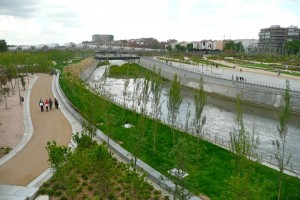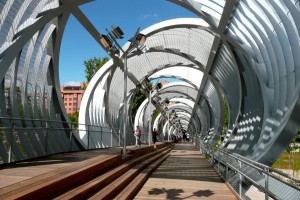Unlike the great rivers of Europe – the Rhine, the Danube or the Seine, so often evoked in art and so historically significant as trade routes or the frontiers of empire, Madrid’s Manzanares is more likely to induce a shrug. Or, as is tradition amongst Madrilenians, a one-liner. In parts completely dry during summer, in other parts a series of large puddles, it’s often not much more than a riverbed with a stream running through it. Or, as one Spanish writer suggested, a trail of saliva.

Descending from the Sierra de Guadarrama to the north of the city before – 87 kilometres later – giving up the ghost and dumping into the River Jarama to the south, it skirts Madrid’s western edge as if ashamed and trying to slink through town without being noticed. It succeeds. Dumas once quipped that he’d wanted to visit the Manzanares while in Madrid, but couldn’t find it. And in the 1970s, the M-30, Madrid’s inner ring motorway, was built alongside its banks. For the modern traveller even if you could find the river, it was so traffic-clogged there wasn’t much point.
But perhaps the best, and in light of recent events, most prophetic Manzanares wisecrack was one made in the latter half of the sixteenth century. Lope de Vega, Spain’s famous Golden Age playwright, was asked for his opinion on the impressive Segovia bridge that had recently been constructed over the modest waters. The playwright replied the city had two options: sell the bridge or buy a river.
Four centuries later Madrid has finally settled on the latter.
In an astounding feat of urban renewal that’s taken eight years, occasioned a budget blow-out and demanded a healthy right-wing disregard for environmental legislation, the sections of the M-30 that flanked the river have been interred – cars now pass through 43 kilometres of underground tunnels – and the banks of the Manzanares have been reclaimed and revamped as an enormous greenbelt.
Just finished in time for summer and running eight kilometres in length, it includes 33,000 and 460,000 planted trees and bushes, respectively, football pitches, fountains, playgrounds, baroque-style gardens, new bridges, restored old bridges, cafes, a BMX track, climbing walls, a concert area big enough for 20,000, an orchard and, even, a beach.
Gallardón’s glory project
An unlikely venture for the bankrupt capital of a country gone belly-up, it’s a glory project for Madrid’s conservative Mayor Alberto Ruiz-Gallardón. He calls the overhauled Manzanares a “reference point for the new Madrid”. Dubbed by his detractors as ‘the Pharaoh’ for his long list of uber-legacy projects, he believes the rejigged river will extend the cultural heart of Madrid – traditionally focussed around the tourist-soaked Puerta del Sol and Paseo del Prado – all the way to the Manzanares.
One late spring afternoon I followed the freshly laid paths as they wove through the undulating parklands. The recently planted adult trees were delicate and thin, having not yet fully taken root. And the calm sounds of passing bicycles and nearby fountains bellied the chaotic tangle of pipes, electrics and vents that lay just below the surface. Some trees have only a metre and a half of substrata before the guts of Europe’s longest urban motorway tunnels begin.
The hot sun, kicking up a spicy aroma of bark chips and fertiliser, had drawn curious Madrilenians to the new park for their afternoon paseo. Joggers – a rare species in Madrid – had converged, as had the elderly. Old women walked in threes, arm in arm, talking over each other about food and their health while old men, wearing cardigans despite the heat, sat silently on benches and stared.
But I wasn’t aware of the river. The Manzanares was canalised in the 1950s and the water sits so low within the canal’s high stone walls that it’s often only visible when standing on a bridge and looking down. In places I saw islands of tangled river weeds breaking the shallow surface and diverting the flow. It looked scarcely navigable, but Gallardón wants to see Madrilenians rowing on his river and the new jetty should be in by autumn.
The mayor is also mindful that Madrid has long chagrined its lack of a beach. Though it’s understandable given the city’s lack of an ocean, Los Refrescos, a now-defunct Spanish pop-band, wrote a number one hit which in the verses catalogued the capital’s virtues, but in the chorus whinged, “But here, there ain’t no beach!”
Early city council pre-visualisations revealed a sandy beach alongside the river, with an ocean-cum-infinity pool for bathing. Architects discussed the space-age sand that would be used – cleaner and more durable than the normal variety. But at some point that idea was quietly scrapped and replaced with what is now commonly referred to as the “beach”.
I saw why. The “beach” was three elliptically-shaped shallow pools, each spouting jets of water or spraying mist into the air. This idea is to relax with your book on the grassy banks and then run under the spouts to cool down. The pools fill with water, though to a maximum depth of three centimetres. Nobody was at the beach today, except a boy riding his mountain bike back and forth across it.
Continuing north, the soft greens were abruptly riven by the new Monumental Arganzuela Bridge. Considered by the mayor to be the focal point of the whole project, it’s a pair of giant silver conical corkscrews that cross the entire park, river included, and meet, almost touching, at a hillock on the eastern bank. Ambitious to the point of nearly not working, it shimmers spectacularly in the sunlight and illuminates at night like a barrelled beacon of light.

From the city’s newest bridge, I pressed on to its oldest. The renovated Segovia Bridge, further north still, was blown up in 1936 by Republicans hoping to halt Franco’s advancing hoards (the hoards waded across). It offers views of the distant royal palace and Madrid’s cathedral and its stones are so perfectly smooth from rain and time that it looks like a polystyrene prop.
And beyond the bridge continued the wide tracts of paved trails, young trees planted in swaths – woods-in-waiting – and new grass, thick and soft, left to grow long before its first mow.
Then it all stopped. Just beyond Príncipe Pío hill the rejuvenation ended and the riverbanks returned to how they had been. Buckled footpaths, collapsed benches and silhouettes dozing under bridges. Bucolic, quieter and oddly beautiful. I heard birds and a man fished from a rock.
And while all that had been improved to the south was handsome and pretty, it was perhaps a bit much for its timid focal point, the Manzanares. This, in contrast, felt right – a humble landscape for a humble river.
.. an interesting English-language article on the river, but the author failed to take into account the success the park is having with the city-dwellers.. on weekends the park is packed with families enjoying picnics and letting their kids play around in the shallow pools, and it’s pretty difficult to navigate on your bike, trying to weave around all the other people walking around. My partner and I find ourselves down in the park nearly every weekend, as we live close by, and it’s quite a pleasant little oasis in the middle of town.